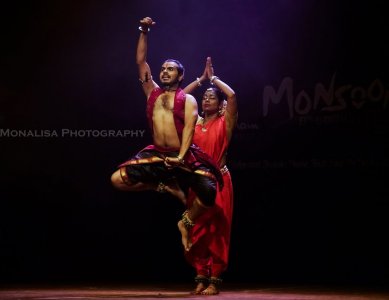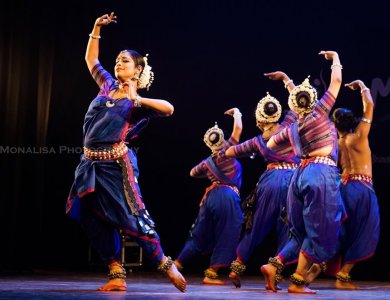
|   |

|   |
Glimpses of Odisha culture - Padma Jayaraj e-mail: padmajayaraj@gmail.com Photos: Monalisa Photography July 23, 2019 Sharmila Biswas and her team from Odissi Vision and Movement Centre, Kolkata, gifted an enchanting night for the art lovers of Thrissur on 8th July 2019 as part of the 8th edition of Navaneetham’s Monsoon Fest. Her dance format presented in the Regional Theatre, Thrissur is the by-product of her research into the evolution of Odissi down the line. Glimpses of cultural Odisha flitted past entrancing the audience. The performance began with an invocation, Devi Bharani, based on a ritual in the Sambleswari Temple in Western Odisha during Dushera. It is a spectacular ritual dance where a group of drummers invoke the spirit of the goddess through the body of a medium. On the stage we see a drummer invoking the goddess through the body of a woman devotee. Devi and the devotee merge in a trance. The dance evokes the mystique of temple ritual worship, going back to the roots of dance as a ritual art in human history. The costume, the vibrant dance steps, and the percussionist as the dancing partner of the duo, present one such traditional ritual in western Odisha. The invocatory number is a tribute to the traditional artistes of the temples of Odisha. Performed by the disciples of Sharmila Biswas who composed the dance to the rhythm composition of Bijay Kumar Barik, the number showcased a ground-breaking item for the audience of Kerala who are familiar only with the conventional repertoire of Odissi. The experimental choreography speaks in volumes of both the dance and the dance director.   The second item Shingar presented by Sharmila Biswas is based on a song written by a Devadasi, Mukta Mahari 150 years ago. The pain and the humiliation that an artist had suffered because of the abolition of temple dance during British regime is the theme of the piece. The dancer, now old and lonely, exiled from the temple, lives in a hut bereft of all her possessions and the glory that made her a wonderful dancer. Although abandoned and alone, inspired by a forgotten song she rises like a phoenix in a magical moment to dance once more. She rises from the ashes of the past to dance once more as the song echoes from her memory. The word Shingar means the dancer adorning herself for a special event. She wraps herself in her ritual costume, decorates herself to enhance her dance. Past impels her into a waking dream. The slow movements and the jathis highlight her gloom. In her own world of enchantment, she meets her lost self. The insensitivity of an alien culture to understand the divine dimension of Indian art and the pain of an artist devoid of cultural sustenance is evocatively brought out. The dancer relives her former glory dancing in her room alone as the song echoes from her memory and the dance happens as a magical fantasy. Past and present merge creating a kaleidoscopic effect for the viewers. Sharmila Biswas presented her alluring dance composition tempered by the music composed by a group of musicians, Ramhari Das, Dhaneswar Swain and Debashish Sarkar. In this piece the accent is on its original ritual dance form of Mahari meaning devadasi; the dance is in Devadasi style that blossomed in the temples of Odisha until it was abolished by the British. Kalashree, the third item, was a nritta piece that showcased scintillating movements springing from chauka, the basic stance in Odissi. Chauka, the square, is one of the two signature postures of Odissi that showcases its strength. To the audience of Kerala who are charmed by the tribangha posture, chauka revealed another mesmerising aspect of the classical dance perfected by later exponents in its evolution. As the group danced, unlimited captivating movements springing from one posture was thrilling. The 10 chauka steps created a wonderland of dance feats that captured the spirit of Odissi. The dance composition set in raag Kalasree, captured the rhythmic movements of time, progressing and expanding into the world of creativity. Music is composed by Debashish Sarkar to the rhythm composition of Dhaneswar Swain.   Katha Surpanakha introduces modern perceptions. The deconstruction of an important story from Ramayana offers a complex theme and fresh perspectives. The solo performance of Sharmila Biswas dramatises the inner monologue of Surpanakha as she looks back to what happened in her youth with its tragic fall out. Racial prejudice is hinted at as Surpanakha repeats how she got infatuated with “Aryan beauty.” Gender bias which haunts the communication gap in Indian society is another suggested theme. Rigidity and the inability to understand and accept other perspectives still ravage India as in olden times. As Surpanakha regrets how she dragged her brother Ravana into the war that destroyed everything, the presentation provokes to ponder over the need for civility in modern times. The dancer makes use of the scope for drama in this abhinaya piece. The use of masks gives a theatrical touch. Rich in nritya, the script, the by-product of considerable research by Jagannath Panda and Sharmila Biswas, is an interesting presentation. Music by Prafulla Kar, Suramani Ramesh Chandra Das, Bijay Kumar Barik and Sukanta Kundu, highlight the complex and contradictory emotions that wage a war within Surpanakha’s persona. Evocation, the last item, highlights the prominence of traditional mrudanga in Odissi. Considerable research led Sharmila Biswas to incorporate the popular percussion instrument mrudanga with its rustic flavour and upbeat energy to enliven the intricacies of her dance. A group performance with mrudanga as the nucleus, Evocation is a glorious tribute exploring the place of mrudanga in the heart of rustic community and popular imagination. Indeed the entire Eastern India lived under its spell as villagers gathered to celebrate arts and music for spiritual exuberance. And mrudanga had flourished with elaborate technique and repertoire as an essential accompaniment for dance. The items were arranged to orchestrate nritta and nritya, alternating solo and group performance to make the presentation a single aesthetic whole. Padma Jayaraj is a freelance writer on the arts and a regular contributor to www.narthaki.com. |